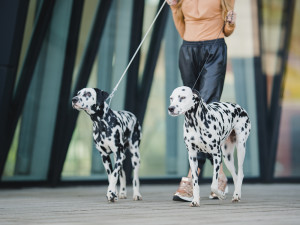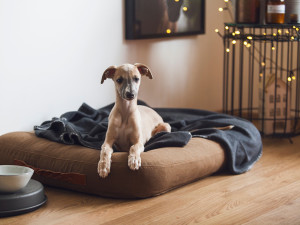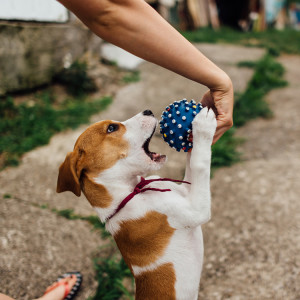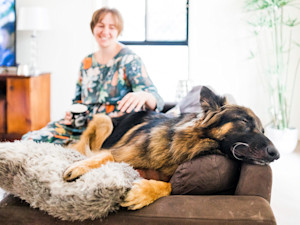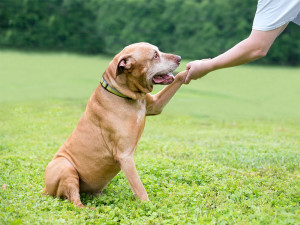How to Teach Your Dog to Heel
With some diligence and some positive rewards, teaching your pup this skill is totally doable.
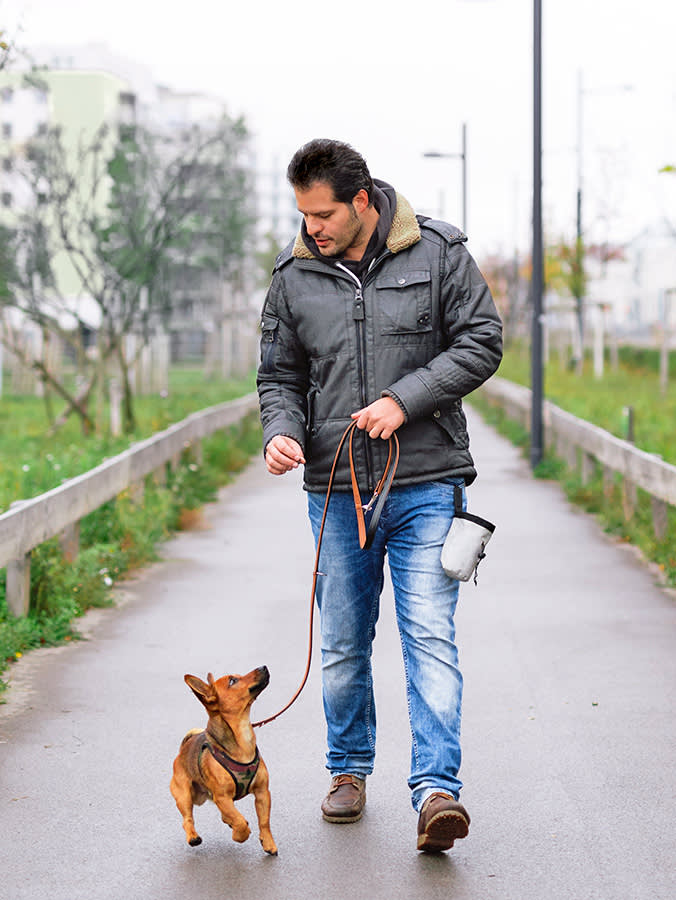
Share Article
In This Article:
What Is the ‘Heel’ Cue? When to Start Training Your Dog to Heel Step-by-Step Guide: Teaching ‘Heel’ Common Challenges How to Stop Your Dog From Pulling on the Leash
In canine speak, the word “heel” cues your dog to walk loosely on a leash by your side. It’s not the same as walking on a leash: Your dog ultimately understands that it means walking beside you at your heel, not bounding in front of you, possibly tugging on the leash.
In this scenario, your dog’s shoulder should align with your knee. When you stop walking, they should sit. Heel position is common in dog sports, rallies, and obedience competitions. For the average dog parent, it’s useful to navigate crowded areas and unpredictable environments such as a crosswalk. It’s also used when greeting people, particularly young children and the elderly.

What is the “heel” cue?
Alexandra Bassett, the lead dog trainer and behavior consultant at Dog Savvyopens in new tab, says heel is a precision-based cue for your dog to walk by your side for a short time. “It’s especially useful when navigating tight spaces, distractions (like other dogs or people), or crosswalks,” Bassett says.
Heeling isn’t a natural canine behavior like sitting or lying down. So the most effective way to approach this is with short, focused training sessions followed by a release cue (such as “free” or “break”), so your dog knows when to end the behavior and relax, Bassett adds.
She trains dogs to heel in context of what she refers to as the reinforcement zone (RZ), a space near your side where your dog learns that “good things happen here. This could be treats, praise, or access to a fun sniff spot. You’re essentially building a strong incentive for your dog to choose to walk close to you.”
When to start training your dog to “heel”
Bassett says you can begin training your dog or puppy to “heel” as soon as you bring them home. Dogs benefit from training no matter their age. Puppies should learn leash training along with other puppy training essentials as soon as you start using a leash.
Once it’s automatic, continue reinforcing it. “One great time to practice is right as you leave the house, using the first heel as a way to earn a sniff break. This sets the tone for your walk: Your dog must pay attention to you to earn rewards,” Bassett says.
Step-by-step guide to teaching “heel”
Bassett helps clients train heel by asking them to first determine their dog’s RZ. “Take a test. Call your dog to you, and see where they hang out. Every dog has an RZ, the place they will seek to find reinforcement,” she says. “Your goal then is to develop a new RZ at your side. This will help develop your dog’s drive to want to walk at your side — thus making loose-leash walking much easier — and return to your side when asked.”
1. Introduce “heel” to your dog.
Begin in a large, enclosed space or a hallway without a leash — because the leash may interfere with a dog’s ability to make independent, thoughtful choices, Bassett says. Walk around the space and call your dog’s name, pointing to the side of your body where you want them to walk (left is traditional).
As soon as they’re by your side, reward them with a treat and verbal praise like “good” or “yes.” Bassett says, “Once the dog consistently stays by the handler’s side as they move — usually after one to three training sessions, depending on the dog’s learning pace — the same exercises can be repeated with the leash attached.”
Verbal cues/physical signals: Once your dog is reliably returning to your side on the leash when you call their name and give them a treat, introduce the verbal cue “heel” and a hand target (the dog touches their nose to your hand).
Holding the leash properly: When introducing the leash, Bassett recommends looping the end of it around the non-dominant wrist to keep both hands free for training. This also helps you avoid accidentally applying tension. “The leash is there as a safety backup, not as a steering mechanism,” she says. “The goal is for the dog to continue choosing to stay by the handler’s side, not to be physically guided there.”
2. Teach the basics indoors.
Heel begins and ends with “sit,” like a home base within the reinforcement zone. In the beginning, when your dog returns to you and sits, move next to them (rather than encouraging them to move next to you). “Most dogs won’t naturally sit by their handler's side. They almost always want to face their handler,” Bassett says.
To counteract this tendency, encourage them to sit, then give your dog a treat immediately to reward them for staying in the sit position as you slide next to them. “Once they are parallel and facing the same direction, the handler will feed the dog from the hip about five to 10 times — visibly holding the treat on their hip, to encourage the dog to look up,” Bassett says. “This builds value for the dog to look up at their handler sideways (rather than turning to face them). It also teaches the dog where you want them to be — either on the left or right side of the body.”
Guide using treats: Treats are essential to effective training. Feed treats from your hip. Be mindful of offering the treat with the hand closest to your dog, so they don’t cross in front of you to get the treat. Bassett tells clients to tap the side of their hip before delivering the treat and reward on the outside of the dog’s body. “You ultimately want to shape a straighter ‘sit’ with good reward placement,” she says.
Practice with short distances: With your dog sitting beside you, walk five to 10 steps, and offer a reward for catching up to you. And end with “sit,” then offer another reward. Do this a few times, then add a release cue to transition to loose-leash walking. This can be a word, phrase, or hand signal, Bassett says. “Popular options are ‘free,’ ‘release,’ ‘go,’ or ‘break.’” A release cue signals it’s time to relax, or at least not perform for a few minutes. This can be considered a reward in itself.
3. Move to outdoor training.
Bassett says once you’re confident issuing the heel cue indoors with minimal distractions — meaning your dog responds correctly nine out of 10 times — begin practicing outdoors.
Start in a quiet place outdoors, like the backyard, then gradually introduce distractions, duration, and distance. Rewarding your dog with treats and a release cue, followed by sniffing, play, or praise.
4. Learning advanced techniques.
Heel is, by definition, a behavior that’s useful for keeping your dog’s attention on you in crowded and distracting situations. So, it’s important to train in those circumstances. From there, you can teach your dog fun and useful tricks such as how to shake hands, roll over, or shake off water on cue. One advanced trick is the Flip Finish Trick, which teaches your dog to move — in one motion — from sitting in front of you to heeling.
Adding sudden stops and changes: With your dog in heel, begin to make sudden stops and turns.
Walking in crowded areas: Venture with your dog (on a leash) into crowded settings, practicing heel at intervals. Keep initial practice sessions short to avoid overstimulating your dog.
Common challenges to learning the heel technique
Basset lists some issues that may disrupt this training process.
If your dog pulls ahead of you on the leash, they may not yet understand the reinforcement zone.
They may also be too excited to focus, in which case training in a quiet environment or after vigorous exercise can be helpful.
They may not be receiving rewards consistently. If reinforcement is delayed or infrequent, heel loses its value.
They get tangled in the leash. Practice good handler mechanics by holding the leash properly and dispensing treats from your hand closest to your dog.
If your dog sits crookedly, take a step back in your training. Ask your dog to sit, then move into the accurate position beside your dog for a few sessions. This may also happen when you reward your dog with the wrong hand.
What if your dog is heeling and a person they know greets them by calling to them? First, it’s helpful to alert friends and family to your training goals, so they don’t derail them. You could also make that part of your training: Ask a friend or family member to call your dog while they’re heeling to demonstrate the strength of the cue.
How do you stop your dog from pulling on the leash?
With a well-trained heel cue, your dog won’t pull on the leash. “Pulling isn’t always disobedience. It’s often just enthusiasm,” Bassett says.
To address pulling, she advises teaching loose-leash walking as your primary walking style. Other tactics include reward-based zone training to reinforce your dog being at your side: stopping your motion the moment your dog pulls, and rewarding your dog the moment the leash slackens, reinforcing self-correction. “If needed, redirect your dog with a cue like ‘Let’s go,’ and turn around, making pulling counterproductive,” she says.
References
Carson, Joanne, and Lois Coryell. Dog Obedience Lesson Plans for Novice Training. 1998. ir.library.oregonstate.edu/downloads/5h73pw073opens in new tab.
“Dog Training: How to Structure a Beginner’s Obedience Class.” MSU Extension, www.canr.msu.edu/news/dog_training_how_to_structure_a_beginners_obedience_classopens in new tab.
“Dr. P’s Dog Training: AKC Novice Pattern.” Uwsp.edu, 2025, www4.uwsp.edu/psych/dog/la/drp9nov.htmopens in new tab.
Lillie, Lisa, et al. “McHenry County 4-H Dog Obedience.” Https://Extension.illinois.edu, University of Illinois, extension.illinois.edu/sites/default/files/wk2_-_obedience_mchenry.pdfopens in new tab.
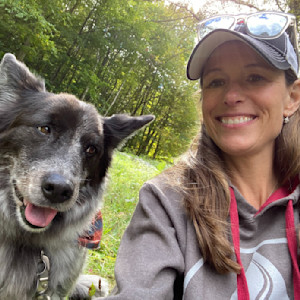
Catherine Fahy Green
Catherine Fahy Green is a journalist turned copy and content writer. As a pets writer, she focuses on and is fascinated by animal body language because there's so much to learn from and about animals by spending time in their presence and observing their physical cues.
Her work as a PR specialist appears in national trade media as press releases and stories about exciting new products people should try. She lives with her family in Western Massachusetts, where she listens closely to the stories her two dogs, flock of chickens, and four horses tell her. She spends her weekends at horse shows with her daughter.
Related articles
![Greyhound puppy sitting on her bed on the bedroom floor]()
Use Platform Dog Training to Elevate Your Pup’s Skills
Using platforms are favorites with pro dog trainers—here’s why you should add them to your training to-do list.
![A dog reaching up to grab a blue ball out of a woman's hand.]()
Playing With Dogs Improves Their Training Success
Post-training play may extend a dog’s memory of previously learned behaviors by up to a year.
![German Shepherd dog napping on couch at home.]()
Teaching Your Dog a New Cue? Make Sure They Take a Nap After
A study says sleep may help your pup better retain new skills.
![A senior Retriever/Terrier mixed breed dog shaking hands with its owner.]()
How to Teach an Old Dog New Tricks
Your senior dog might move slower these days, but that doesn’t mean they can’t learn new things.
![Boston terrier being stubborn]()
Dog Training — DIY or Hire a Pro?
When it’s time to call in reinforcements.


